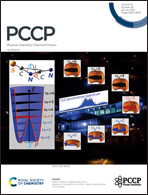Er3+ doped nanoparticles as upconversion thermometer probes in confined fluids†
Abstract
Non-contact temperature measurement at the nanoscale by photoluminescence using a nano-sensor in a confined fluid has been performed in the present work. Upconversion lanthanide-doped nanoparticles applied to ratiometric thermometry could be considered as a self-referenced nanosensor. Gadolinium orthovanadate (GdVO4) nanoparticles doped with Yb3+ and Er3+ were synthesized and then dispersed in an ester-based fluid. Rheological measurements show that the viscosity of the dispersed NP suspension remains unchanged up to a shear rate of 10−4 s−1 at 393 K. The NP suspension allows luminescence intensity ratio (LIR) thermometry up to 473 K with a relative sensitivity of 1.17% K−1 with a NIR laser. Then, the temperature calibration by coupling the high pressure (1.08 GPa max) confirmed the applicability of NPs as a thermosensor in a variable pressure environment. According to these results, the fluid containing GdVO4:Yb3+/Er3+ nanoparticles can be used for temperature sensing in a pressurized environment for further application in tribology.



 Please wait while we load your content...
Please wait while we load your content...